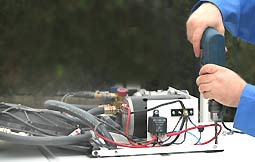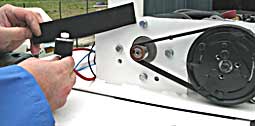Département Climatisation
- Applications Hy-Gloo
- Who to choose Hy-Gloo?
- Technical specifications
- Technical options
- Dimensions, weight
- Test in laboratory
- Maintenance
- To construct its Hy-Gloo
- Video installation
- Hy-Gloo Integre version
- DDPA general
- Contact
Other sites DDPA:

Air-Conditioner HY-GLOO , air conditioning unit designed for use in vehicle cabins
Air conditioning equipment fitted on a Citroen Berlingot
Vehicle Citroën Berlingot diesel
equipment origin, alternator origin, mileage of 170000km, no insulation, separation between seats before and volume delays by a simple plate of plywood.

With a size or by measuring, to cause the position of future drillings to accomplish on the vehicle.


Having pierced holes in the desired diameter, having put down Hy-Gloo by intercalating a carpet or by taking silent-blocks up.


Example of assemblage with silent-blocks for use on vehicle or device causing vibrations.

Pierce the roof of the vehicle in order to allow the passage of the flexible. Use necklaces "pass-partition" and reinforce waterproof quality by using a coating silicone type.

Pass the flexible and cables electrical of feeding inside the cockpit.

Put down the horizontal evaporator and fix it by the points of attacheprévus. Link 2 joins low and high pressure. Attention to the joints of étanchéîté.

Link the flexible tubes of exits of condensats and run them in order to get an easy flow towards the outside.

The evaporator of cabin is connected and is to the electrical beam. The order of air-conditioning will be made by 2 buttons; choice of speed and regulating of temperature.

Pose of the external bonnet by 6 compulsory points of fixing.

Electrical connection of 2 cables on demarcations + and - of the battery. Prove the fuse protecting Hy-Gloo.

Prove that the alternator of the vehicle is adapted at the request of Hy-Gloo. About 50 Amperes in 12 Volts.


Trial of the vehicle equipped with HY-GLOO:
- performances
On the 24.04.2007, the vehicle is displayed in hot sun for the 5 hours of time. The vehicle is type van with simple separation in plywood behind seats. No particular insulation.
The external temperature is 31 ° in 32 ° in 13h10mn.
The temperature in the cockpit is 42 °.
The vehicle starts at 13 h 10mn and immediately sets off.
1 thermometer is positioned at the exit of the mouths of cold air.
1 thermométre measure the temperature of the air inhaled by the system.
1 thermométre measure the temperature of the cockpit as high as the head of the driver and as high as legs.
After 5 mn of functioning, air is inhaled in 42 ° is forced back in 19 °.
The feeling of fraicheur apparait.
Afterwards 30mn of road, the temperature as high as the head of the driver is 25 ° and 24 ° as high as legs.
The external temperature is always included between 31 and 32 °.
The difference of temperature between air inhaled and forced back is always from 20 to 21 °.
.............
The vehicle is stopped turning engine during 10mn.
The temperature inside the cockpit is stabisiée in 24, 25 °.
The vehicle takes back the road and performances remain identical.
A check of supports of temperature in the cockpit, vehicle parked in the sun, engine turning at a slower pace.
Temperature extéieure in shadow 32 °
Drée of the arrét 30mn.
Temperature in the habtacle aprés 30mn: 26 °.
Conclusion: Hy-Gloo Génération III assures his function perfectly and gives a very good level of comfort.
To note that all these trials took place with closed window panes and admisssion of external air cut.
Impression of behaviour:
During 800 km, on road in expressway, on motorway, on road of mountain, no difference of determined behaviour.
No catch in the lateral wind, no sound effect or vibratory at maximum speed (140km / h)
No loss of power on the engine of the vehicle: atmo diesel of PSA with 170.000km.
Precaution:
No more visit car washes with rolls.
Prove the cleanness of the condenseur and clean with the air blown preferably.
Height of the vehicle changed of 16cm but any problem of portico of motorway or of underground parking.